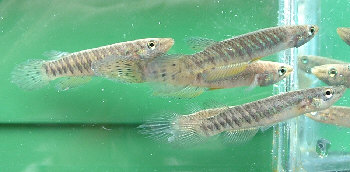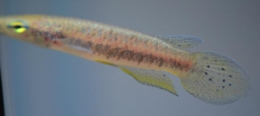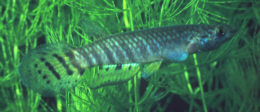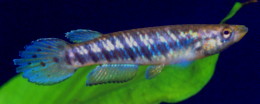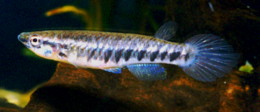Epiplatys spilargyreius (Duméril 1861)
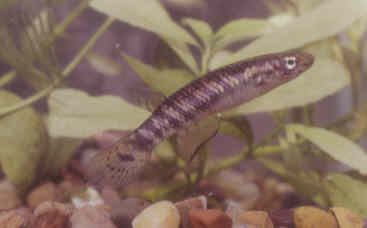
E.spilargyreius Sare Alpha
| Meaning of Name |
Refers to the body showing incomplete spots. |
||||||||||
| First Description |
Duméril A.H.A. 1861. Reptiles et poissons de l'Afrique occidentale. Etude précédée de considerations générales sur leur distribution géographique. Archives du Museum National d'Histoire Naturelle, Tome 10 (1861): p 258-259. |
||||||||||
| Size |
6 cm |
||||||||||
| Meristics |
|
||||||||||
| Karyotype |
n = 17, A = 34 (Scheel 1990) |
||||||||||
| Sub-Genus |
Epiplatys |
||||||||||
| Group |
spilargyreius |
||||||||||
| Synonyms |
|
||||||||||
Populations
|
Kaduna - Collected by Stanley (Livingstone) Cox 1978/79.
Pool Malebo - Collected 1982 (Z82). Most likely fish from this large area commercially collected.
|
||||||||||
| Type Locality |
Given as 'Freshwater of the Maningues Coast'. This relates to the Senegal/Gambia coastline. |
||||||||||
| Distribution |
Very large area of distribution. They are found on the Senegal & Gambia coastline eastwards to the Nile River of eastern Africa. To the south they inhabit Cameroon, Central African Republic & Zaire. http://homepage.uibk.ac.at/homepage/c102/c102mr/epiplaty/spilargy.htm |
||||||||||
| Habitat |
Quiet water areas of small rivers, streams & swamps. Also found in small bodies of water in savannah areas.
Biotope of E.spilargyreius
near Garoua, Cameroon. |
||||||||||
| Distinguishing Characteristics | Slanting vertical lines down the body. They seem to have a shape & appearance unlike other members of the genus. Their is a black band on the outer margin of the anal fin in all photos & line drawings I have seen. | ||||||||||
| Colour/Pattern Variability | High | ||||||||||
| History |
Boulenger gives the following collectors / locations in his 1915 Catalogue.
First imported to the UK from a BKA import sent over by David Blair 1969/70. Another import came into the UK around 1972. This form was regarded as being more colourful & probably collected in Nigeria. Collected by Geoff Wood in the Malebo Pool (then known as the Stanley Pool) 1974 / 75. History of the synonym Poecilia spilargyreia Dumeril 1861 Dumeril described this sp. from 2 small
specimens obtained from M.Schill who was captain of a Russian merchantman.
He collected them from the Madingue Coast (Senegal-Gambia area) area
in freshwater. In 1925 Pellegrin reported that Rochebrunne (in 1883)
stated that the type locality of the sp. is situated either on the Falema
River or near to the falls on the Gouma River. Both these localities
are situated far inland. Rochebrunne's source of this information is
unknown however. History of the synonym Haplochilus senegalensis Steindachner 1870 Steindachner described this sp. from
3 specimens collected at Dagana located near the mouth of the Senegal
River. The largest specimen had many narrow dark crossbands which was
lacking in the other 2. These 2 were thought later to represent E.bifasciatus. History of the synonym Haplochilus marnoi Steindachner 1881. Steindachner described the species from fish collected from Bahr-el-Seraf & Bahr-el-Gebel, Nile drainage. In 1895 Garman considered they represented a synonym of senegalensis. Collected by Loat at Lake No. Werner collected them at Mongalia near Gondokoro, Sudan. Werner reported them to be common at Gonga in vegetation along the river banks. He also found them at Renk. He considered these fish to be livebearers as one individual is reported to have given birth to a fry with a yolk sac during preservation. King collected them at Khor Barbry in 1913. The colouration of this collection included 3 dark crossbands in the caudal fin. Lewis collected them in 1948 at Lake No. History of the synonym Haplochilus senegalensis acuticaudatus Pellegrin 1934 In 1913 Pellegrin used 4 specimens from Guidimoussi, just east of Zinder, Niger Republic (Chad drainage) to describe this subspecies. Pellegrin based his description on elongated fin rays in the centre of the caudal fin which he considered seperated them from senegalensis (now a synonym of spilargyreius). This feature is known to be a variable in spilargyreius. History of the synonym Panchax grahami decemfasciata Pellegrin 1913 Pellegrin had a single specimen from Bobo-Dioulasso, High Volta & 2 collected in a small brook 100 km from Bougouni in the direction of Odiennes, Ivory Coast. |
||||||||||
| Breeding Notes |
A difficult species to breed despite its success in distribution. You would expect a species this successful to be easy. I had a population from Sare Alpha in the 1980's but failed to breed them. At the time I only had hard tap water DH10. No doubt rainwater would prove more successful. Reports suggest they lay eggs in floating mops / plants which will water incubate for 10-14 days. Fry are small on hatching & require infusoria as a starter food. Growth rate is quite slow with sexual maturity at about 7-8 months of age. A report on the first fish to come into the BKA can be found in newsletter No.85, September 1972. Water temperature 74° F, pH 6·8, DH 4-7. This import proved easy to breed in well planted tanks. Eggs were laid in the bottom areas of the tank. These were taken out & incubated in a seperate container. Fry were fairly large on hatching & able to take newly hatched brine shrimp as a first food. Growth rate was observed as being 'not very rapid'. First signs of sexing out were observed in the anal fin where 3 spots appeared in male specimens. This started to show at 4 months of age. |
||||||||||
| Diameter of Egg | |||||||||||
| Remarks |
|

